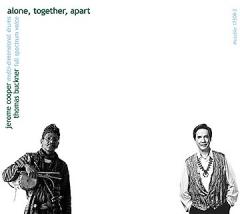JEROME COOPER & THOMAS BUCKNER / Alone, Together, Apart
Jerome Cooper (multi-dimensional drums); Thomas Buckner (full spectrum voice)
Jerome Cooper's playing here stands out for its uniquely light but driving touch, although he spends only a fraction of the disc on drumset, moving to keyboard, hand and mallet percussion and "tonal rhythm activator" for long stretches. Thomas Buckner's voice on this set of live duo improvisations delves into low groans, high cries and semi-operatic stylings, but steers clear of harshness. This is meditative music-the titles ("Evocation," "Journey," "Return") give a strong suggestion of what their intentions were, and what they achieved. Avoiding poking and prodding, Cooper and Buckner work alongside one another patiently, on the same wavelength.(Pat Buzby, Signal to Noise)
TRACK LIST
Alone, Together, Apart:
Evocation (24:46)
Journey (8:45)
Return (16:17)
All Out (4:06)
REVIEWS
A classically trained vocalist, Buckner has been experimenting with creative voice techniques in improvisational settings for more than 30 years. Internationally known for his leading roles in many of Robert Ashley's operas, he often works with collaborators from the so-called legit and so-called jazz worlds including Alvin Lucier, Pauline Oliveros and Roscoe Mitchell, and presents an annual recital at Merkin Concert Hall in New York. His partner on Alone, Together is another veteran. Jerome Cooper has impeccable New Thing connections and was a member of the Revolutionary Ensemble in the 1970s. Since then he has concentrated on travelling the world and creating a solo repertoire for percussion.
Benefiting their senior status, Buckner, using his full-spectrum voice, and Cooper, on a variety of percussion instruments, approach the four spontaneous improvisations with the same aplomb as if they were respectively vocalizing an early music motet or playing a straight jazz tune.
Lead off track, "Evocation," is obviously the showpiece at nearly 25 minutes. At first, Cooper busies himself with producing sliding tones on a variety of African and African-American percussion instruments as Buckner works his way from tree-top high, choked, counter-tenor tones to rumbling baritone outpourings. Concentrating on the resonating wooden tones of the West Africa balaphone, the percussionist creates a counterline to the singer's most expressive work. Spilling out syllables that sound like words but are in no language, Buckner's restrained voice resembles that of a cantor, davening during a synagogue service. But since his syllable elisions adds bent blue notes to a cantor's usual singsong delivery it would seem to be a synagogue that's situated within an African American community. Finally, with Cooper hitting the ride cymbal for emphasis, Buckner produces a yawning, modified growl that also echoes the sound of ebb tide.
"Return" include a verbal bow to traditional scat singing when Buckner's syllables work to amplify and modify talking drum patterns. Earlier, the tonal rhythmic activator creates contours when his voice takes on Native American, shamanistic qualities, followed by a sort of looping operatic tones, pants and Bronx cheers for emphasis. In response the drummer executes a set of roughs, drags and ratamacues matching the vocal phrasing.
The duo's work also suggests pygmy chanting, speaking-in-tongues, animal cries and mysterious Indo-European word play on the vocal side, while Cooper flits from sock cymbal to bass drum to electric keyboard used both as electric piano and synthesized strings for more expansion coloration.

